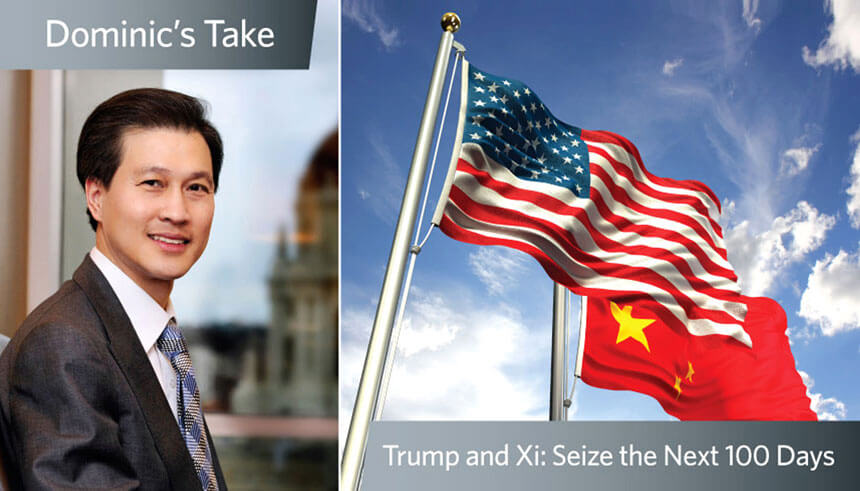US-Asia Business
Trump and Xi: Seize the Next 100 Days
By Dominic Ng

East West Bank CEO Dominic Ng urges both sides to capitalize on bilateral opportunities.
Those of us working in cross-border business were relieved to see the first face-to-face meeting between Presidents Trump and Xi conclude on a positive note, given President Trump’s tweet predicting a “very difficult meeting” the week before. Instead of taking public hard lines towards each other, the two leaders emerged touting a productive new friendship and a commitment to produce results on trade negotiations within 100 days.
Now comes the hard part — hashing out the details. I strongly urge both sides to use this opportunity to come together the next 100 days and act on areas of mutual benefit.
It would be a mistake to believe that the summit has averted trade and investment frictions between both nations. A host of U.S. policy reviews are underway, which may result in tougher policies on foreign direct investment (FDI), trade, currency, intellectual property and other matters in the months ahead. Since President Trump is backing away from his campaign promise to declare China a currency manipulator, he will need some alternative demonstration of “wins” vis-à-vis China. To sustain positive U.S.-China momentum coming off the Mar-a-Lago Summit, the two sides must actively demonstrate progress on areas of mutual commercial interest, and soon balance out what will be a full plate of more nationalistic steps.
Infrastructure
Investment in U.S. infrastructure is one under-appreciated opportunity. The U.S. Chamber of Commerce predicts that more than $8 trillion in new investment will be needed in U.S. transportation, energy, and water-related infrastructure through 2030—totaling some $455 billion per year. The pressing need to modernize U.S. infrastructure is creating substantial new opportunities to put Chinese capital to work productively. Finding ways to allow Chinese investment to help make American infrastructure great again—employing blue collar American workers and sourcing the majority of their inputs locally—would be a powerful win for President Trump. Chinese capital can help make this happen quickly, and Trump would be able to kick-start the building of new airports, highways, bridges, and other large infrastructure projects, bringing immediate tangible benefits and jobs to the local communities and generating goodwill. It would be a win for both sides.
Automotive
The U.S. and other foreign countries have a strong interest in better access to the Chinese auto market. Currently, imported cars face a 25 percent tariff in China, making foreign-built automobiles more expensive for Chinese buyers. There is also a 50 percent foreign equity cap on automobile joint ventures, limiting potential profits for foreign firms and opening them up to unwanted technology transfer risks if they want access to the Chinese market. Lifting these equity caps on joint ventures is one way Beijing could show seriousness about FDI reforms, while at the same time stimulating capital inflows and disciplining overcapacity problems.
Agriculture
Presidents Trump and Xi could focus on revising rules governing the import and export of agricultural goods. Reducing tariffs and especially non-tariff barriers to U.S. beef and other agricultural goods would be a quick way to boost U.S. exports to China, and it would especially please Trump’s constituency in agricultural states. China implemented a ban on U.S. beef imports in 2003 following a case of mad cow disease that is still in effect today, despite growing beef demand in China and rising imports from competitors in Australia, Brazil, and elsewhere. Reversing the ban would be a symbolic down payment on China’s commitment to address the trade imbalance with the United States. There are early indications this may happen soon. After the summit, researchers at a think tank under the Chinese Ministry of Commerce predicted that China will likely increase soybean and pork imports from the U.S. and lift the ban on U.S. beef imports as some of its first steps towards narrowing the trade imbalance between the two countries.
Financial sector
Greater foreign participation in China’s financial sector is another win-win opportunity for China and the United States. Xi signaled a willingness to offer better market access for financial sector investments, so negotiators should act on that momentum. With corporate debt levels and financial risks rising, Beijing has no choice but get on a faster track towards financial sector modernization. Past experience with banking privatizations has shown that foreign participation can contribute meaningfully to modernization efforts, as foreign financial institutions have more experience in efficiently allocating capital in a maturing economy. Increasing openness to foreign investors in China’s financial market would also go a long way to ensure that Chinese firms can continue their expansion abroad (which is one of the areas with strong growth momentum in the U.S.)
Pick low hanging fruit
The first Trump-Xi summit was a success in that it established an expectation of future cooperation, but the calm is fragile. Without progress on mutually beneficial “low-hanging fruit” like those addressed above, there is a significant chance that confrontational tactics will come to dominate the relationship, at the cost of the economies of both countries. The 100-day plan will set the tone for the relations between the two countries for the next four years. The G-20 Summit in Germany in July will be the next opportunity for the two leaders to meet. If progress can be made that allows President Trump to claim success in rebalancing the U.S.-China trade relationship, then he will be able to take a less confrontational posture in the future and create win-win scenarios for both countries.
Sign up for the Reach Further Newsletter
We’ll keep you in the know about the latest US-Asia business news and trends.
Suscríbase al boletín Reach Further
Lo mantendremos informado sobre las últimas noticias y tendencias comerciales entre Estados Unidos y China.

